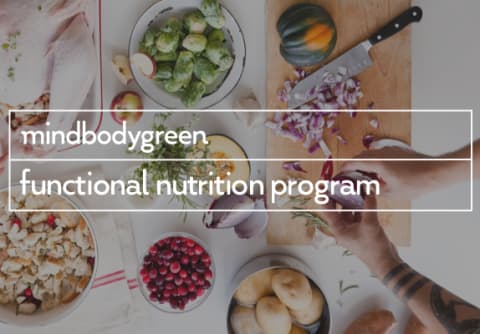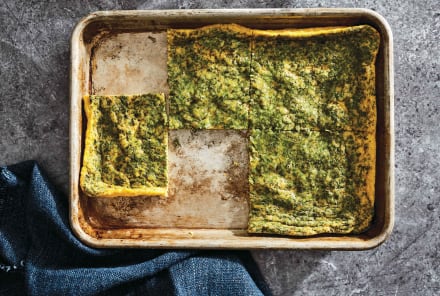Advertisement
The Simple Elimination Diet That Could Change Your Life Forever

I recently saw a patient who came in for a food allergy test. She left with an elimination diet.
While allergy testing can be illuminating, the “gold standard” in figuring out if foods are causing your inflammation (which can lead to everything from autoimmune arthritis, to an irritable bowel, to acne), is by cutting out the culprit foods for about a month and see how you feel when you reintroduce them.
I actually recommend that everyone—yes everyone—do an elimination diet at least once. So how do you do it and not make it complicated? Here is my easy 5-step plan for doing your own elimination diet. You might be surprised by what you learn!
Step 1: Take stock of your symptoms.
Do you have skin issues? Digestive issues like gas, bloating, or intermittent constipation? Bad allergies? How's your energy level? What about your mood? Ever feel like you suffer from brain fog? These are just some potential symptoms of food sensitivities.
So, before you begin an elimination diet, make a list of everything you notice in your body, however subtle or long-standing the symptom has been. This assessment will allow you to notice the important changes when they happen on the diet.
Step 2: Eliminate the usual suspects for 23 days.
The basic elimination diet is as simple as this: No gluten, dairy, eggs, soy, fast food, or alcohol for 23 days.
Why 23 Days?
Antibodies, which are the proteins that your immune system makes when it reacts to foods, take around 21 to 23 days to turn over. So, if you don’t quit those foods you're sensitive to for at least that time frame, you won’t experience the true effects of elimination.
Why Booze?
Alcohol also has a lot of sugar that helps things like yeast and harmful bacteria in your gut thrive. So when you eliminate alcohol, you may feel better in a few weeks, not just because of the absence of a sleep disruptor and a depressant in your life, but because you've actually changed the flora in your gut that are critical to keeping you healthy!
Step 3: Create your grocery list
You might be thinking: "Cr*#! What do I eat?" If this is your reaction, don't freak out! You can do this. The diet requires a little grocery shopping and taking just a few extra minutes a day to prepare your food.
New habits take 21 days to form, as the yogis say, which is also why a 23-day elimination diet is important. We want these new habits to remain intact.
That said, your grocery list should comprise of:
See, it’s that simple! Here's the full breakdown of what you should eat and what foods you should avoid.
The Do's:
- Eat fish. (But watch out for fish on the NRDC’s high mercury list like tuna and swordfish.)
- Eat lots of fiber, fresh whole foods, and unprocessed meals you make yourself.
- Eat lots of healthy fats found in olive oil, ghee, coconut oil, sunflower oil, flax oil, walnut oil, and avocados.
The Don'ts:
- Don't eat processed health bars if possible. They often have 15 grams (or more) of sugar. If you need them for an emergency snack, the kinds I like are Go Raw pumpkin bars and Kind’s “Nuts and Spices” variety, because they are very low in sugar.
- Don't carbo-load on gluten-free breads, cereals and crackers. While it's totally cool to eat some of these, don't just replace a lot of refined carbs with a lot of gluten free refined carbs. Watch out for oats, unless they're gluten free!
Step 4: Re-introduce eliminated foods after 23 days.
This is also much simpler than people make it out to be. On day 24, you can choose to eat one thing you eliminated—like gluten, or dairy, or eggs—but not more than one.
See how you feel over the next 48 hours. If you have no reaction after two days, eat that same food again for a second time, and notice how you feel. From there, it’s up to you whether or not to re-incorporate that food into your diet on a regular basis. Once you’ve made a call on the first food you reintroduce, pick another one and follow the same steps.
Step 5: Continue to listen to your body!
Throughout the diet and the reintroduction process, notice how you feel. Maybe you'll see changes you weren’t expecting. Maybe your sleep quality or your energy level is better. Maybe the redness in your skin is gone, or your belly is flatter.
No blood test can tell you what life without a particular food will be like—the key here is experimenting. When you find out for yourself, you could be saving yourself a lifetime of inflammation, annoying symptoms, and in some cases, chronic diseases.
Watch Next
Enjoy some of our favorite clips from classes
Enjoy some of our favorite clips from classes
What Is Meditation?
Mindfulness/Spirituality | Light Watkins
Box Breathing
Mindfulness/Spirituality | Gwen Dittmar
What Breathwork Can Address
Mindfulness/Spirituality | Gwen Dittmar
The 8 Limbs of Yoga - What is Asana?
Yoga | Caley Alyssa
Two Standing Postures to Open Up Tight Hips
Yoga | Caley Alyssa
How Plants Can Optimize Athletic Performance
Nutrition | Rich Roll
What to Eat Before a Workout
Nutrition | Rich Roll
How Ayurveda Helps Us Navigate Modern Life
Nutrition | Sahara Rose
Messages About Love & Relationships
Love & Relationships | Esther Perel
Love Languages
Love & Relationships | Esther Perel












